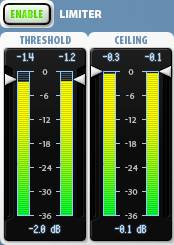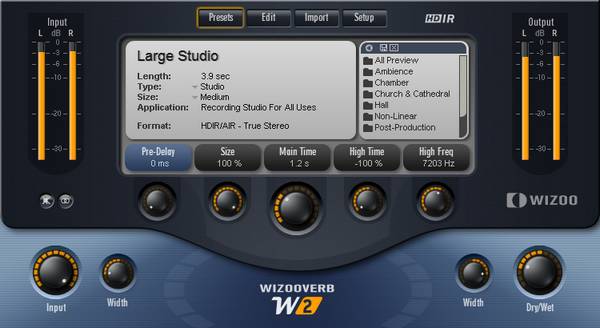

? | Home page | Tutorial | Mixing in practice | Drums





The drums are routed as follows:
MIDI AND AUDIO DRUM TRACKS The MIDI track contains the drum score itself. It is linked to the audio tracks of each drum element. Each one of the audio tracks is routed to the corresponding bus (snare drum track routed to snare drum bus, etc.)  |
|||
 |
|||
Bus KICK DRUM |
Bus SNARE DRUM |
Bus CYMBALS (hi-hat, crash, splash, ride) |
Bus OVERHEAD |
| DRUMS bus |
|||





Final Plug is a commercial plugin, you will find free limiters here, as well as a compressor (that can also be used as a limiter with the appropriate settings).
A limiter will boost the sound by defining a bottom volume from which the sound will be raised up to the maximum ceiling value









Final Plug is a commercial plugin, you will find free limiter plugins here, as well as a compressor plugin (that can be used as a limiter with the appropriate settings).
A limiter allows to boost the sound by setting a threshold level from which the sound will be raised up to a defined ceiling value.

Wizooverb is a commercial plugin, but it is no longer sold, which is a pity because it's excellent. You will find free reverb plugins here. You can find a lot of alternatives on the Internet, with various levels of quality.


Messages page # 1 2 3 4 5 6 7 8 9 10 11 12 13 14 15 16 17 18 19 20 21 22 23 24 25 26 27 28 29 30 31 32 33 34 35

FromMe
le 13/10/2025 à 12h14
Hello.
So how can I contact LePou?
The latest X64 version of Legion has a bug where the Drive amount jumps when changing from green/red channels. The knob doesn't jump, but you can hear the drive amount jump when tweaking a little bit, so who knows what the default or chosen sound is being used whenever?
Also similar problems with the Engl as well. The old V 1.01 x86 32 bit version of Legion works perfectly however. (but the newer 64 bit version does sound a bit better, sadly).
Has you or anyone else noticed this?
I want to contact him for a way to fix these plugin bugs.
* * * * * * * * * * * * * * * *
Hello,
To my knowledge, Lepou has not been active for years in the simulation community. I think he has completely given up by lack of time and motivation. So I doubt he'll be willing to fix any bugs, and I have no idea how to contact him.
Grebz

musicien-bidouilleur
le 07/09/2025 à 17h58
Juste pour t'encourager et te féliciter pour ton travail. Bonne source d'informations.
J'ai écouté en partie ta musique : il y a un monde entre 2008 et 2020, non pas concernant les titres que j'aime bien mais concernant leur réalisation. 2020 >>> 2008 à mon humble avis.
Le travail et la persévérance paient !
Bravo.
* * * * * * * * * * * * * * * *
Merci beaucoup, ça me fait très plaisir !
Grebz

ace0fspades
le 25/08/2025 à 05h50
Thanks for the free impulses! Great stuff!
* * * * * * * * * * * * * * * *
Thanks for visiting!
Grebz

Jimmy
le 09/12/2021 à 15h16
Hello,
I would like to config my Schuffham S-Gear 2 but I don't know how to do.
I have Logic Pro X.6.2 with S-Gear plugin
I found your website and I ask myself what does it means in the folder Schuffham S-Gear 2.
I don't understand what you have writing like in this exemple : Guitar on the left:
1 impulse of baffle Marshall 1960A (loudspeaker: G12M) through a microphone Neumann U67 in Cap Edge position, at a distance of 2 inches (5 cm). Stereo panning: 100% left.
1 impulse of baffle Marshall 1960A (loudspeaker: G12M) through a microphone Neumann U87 in Cap Edge position, at a distance of 4 inches (10 cm). Stereo panning: 100% left.
How can I find the same sound as you ? How can I do to config my own S-Gear with these parameters ? What does it means ?
Sorry for my English ;) I’m French !
You can answer me directly on my email address.
Thanks in advance.
Jimmy

Labrava
le 29/10/2021 à 13h49
Hi Grebz,
I don't know if you read these... but I was wondering if your Lepou plugins are x32 or x64? Thanks for all the great stuff on here!
* * * * * * * * * * * * * * * *
Hello, thanks for visiting my website. They're x64.
Grebz
